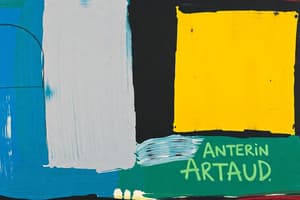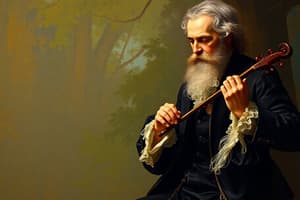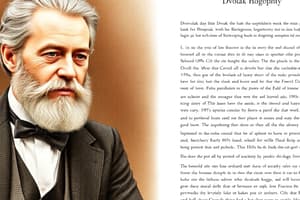Podcast
Questions and Answers
What is the meaning of 'Starodávný' in the context of Slavonic Dances?
What is the meaning of 'Starodávný' in the context of Slavonic Dances?
A traditional dance that is fondly remembered
Where is Moravia located?
Where is Moravia located?
Moravia is a historical region adjacent to Bohemia in the east of the Czech Republic
Were the Slavonic Dances intended for dancing?
Were the Slavonic Dances intended for dancing?
No, they were intended only for listening
What are some compelling elements of the Slavonic Dances music?
What are some compelling elements of the Slavonic Dances music?
What was the original form of the score provided for Slavonic Dances?
What was the original form of the score provided for Slavonic Dances?
What are the Slavonic Dances?
What are the Slavonic Dances?
When were the Slavonic Dances composed?
When were the Slavonic Dances composed?
How many Slavonic Dances are there in total?
How many Slavonic Dances are there in total?
What are the opus numbers of the two sets of Slavonic Dances?
What are the opus numbers of the two sets of Slavonic Dances?
What type of music are the Slavonic Dances?
What type of music are the Slavonic Dances?
What is Antonín Dvořák's most well-known work?
What is Antonín Dvořák's most well-known work?
Where was Antonín Dvořák born?
Where was Antonín Dvořák born?
How many children did Antonín Dvořák have?
How many children did Antonín Dvořák have?
What did Brahms recommend Antonín Dvořák for?
What did Brahms recommend Antonín Dvořák for?
How did Antonín Dvořák become an international celebrity?
How did Antonín Dvořák become an international celebrity?
What inspired Dvořák to write the Slavonic Dances?
What inspired Dvořák to write the Slavonic Dances?
What important differences exist between Brahms's Hungarian Dances and Dvořák's Slavonic Dances?
What important differences exist between Brahms's Hungarian Dances and Dvořák's Slavonic Dances?
What musical form were the Slavonic Dances originally written for?
What musical form were the Slavonic Dances originally written for?
What was the publisher's reaction to Dvořák's music for the Slavonic Dances?
What was the publisher's reaction to Dvořák's music for the Slavonic Dances?
How did the Slavonic Dances impact Dvořák's reputation?
How did the Slavonic Dances impact Dvořák's reputation?
What was the title of the first piece by Debussy to truly declare his independence of thought?
What was the title of the first piece by Debussy to truly declare his independence of thought?
In what year did Debussy complete his opera Pelleas et Melisande?
In what year did Debussy complete his opera Pelleas et Melisande?
Which poet inspired Debussy's highly innovative piece Prelude a l'Apres-midi d'un Faune?
Which poet inspired Debussy's highly innovative piece Prelude a l'Apres-midi d'un Faune?
What was Debussy's compositional style known for?
What was Debussy's compositional style known for?
What musical movement is Debussy regarded as the founder of?
What musical movement is Debussy regarded as the founder of?
At what age did Debussy win a place at the Paris Conservatoire?
At what age did Debussy win a place at the Paris Conservatoire?
Who employed Debussy as a pianist in his early career?
Who employed Debussy as a pianist in his early career?
Which painters influenced Debussy in his compositional style?
Which painters influenced Debussy in his compositional style?
What type of moods did Debussy often evoke through his music?
What type of moods did Debussy often evoke through his music?
What event marked the beginning of Debussy's new creative phase in 1903?
What event marked the beginning of Debussy's new creative phase in 1903?
Who did Debussy marry in 1905 after divorcing his first wife?
Who did Debussy marry in 1905 after divorcing his first wife?
What illness did Debussy discover he had in 1914?
What illness did Debussy discover he had in 1914?
What piece did Debussy complete before his death in 1918?
What piece did Debussy complete before his death in 1918?
Who was Debussy's Children's Corner Suite dedicated to?
Who was Debussy's Children's Corner Suite dedicated to?
Where was Debussy staying when he observed that 'the sea behaves with British politeness'?
Where was Debussy staying when he observed that 'the sea behaves with British politeness'?
What famous composer was Emma Bardac a one-time mistress of before marrying Debussy?
What famous composer was Emma Bardac a one-time mistress of before marrying Debussy?
What is seen by many as Debussy's most influential work?
What is seen by many as Debussy's most influential work?
Which composer's music did Debussy consider to be his final masterwork?
Which composer's music did Debussy consider to be his final masterwork?
Study Notes
Claude Debussy (1862-1918)
- French composer and one of the most prominent figures in impressionist music
- Born on August 22, 1862, in Saint-Germain-en-Laye, France
- Showed an early gift for the piano and won a place at the Paris Conservatoire in 1872 at the age of 10
- Influenced by Symbolist poets and Impressionist painters, leading to a compositional style of great originality
- Regarded as the founder of musical Impressionism, using unusual voice leading and timbral colors to evoke pictorial images and moods
- Completed his first piece, "Prelude a l'Apres-midi d'un Faune," in 1894, which declared his independence of thought
- Notable works include:
- Opera "Pelleas et Melisande" (completed in 1902)
- Orchestral "Nocturnes" (completed in 1899)
- "La Mer" (completed in 1903)
- Piano music "Suite pour piano", "Suite Bergamasque", "Estampes", "Images", and "Children's Corner"
- Chamber music "String quartet", "Cello sonata", and "Violin sonata"
Children's Corner Suite
- A suite of piano pieces written by Debussy in 1908
- Dedicated to his daughter Claude Emma (nicknamed Chou-Chou)
- Consists of six pieces, including "Gollywog's Cakewalk" which is the final piece in the suite
Antonín Dvořák (1841-1904)
- Czech composer of Romantic music, employing the idioms of folk music from Moravia and Bohemia
- Born in 1841 in a small village north of Prague in Hungary
- Grew up in a musical household and received early music education from his village schoolmaster
- Studied organ, violin, piano, and music theory at the Organ School in Prague
- Became a violist in the orchestra of the Provisional Theatre, where he met his future wife, Anna Čermáková
- Notable works include:
- Symphony No.9, "From the New World"
- Slavonic Dances (Opus 46 and Opus 72)
- String Quartet No.12, "American"
- Cello Concerto in B minor
- Opera "Rusalka"
Slavonic Dances
- A series of 16 orchestral pieces composed by Dvořák in 1878 and 1886, and published in two sets of 8 as Opus 46 and Opus 72, respectively
- Inspired by Johannes Brahms's Hungarian Dances, but with a distinct difference in using characteristic dance-like rhythms of Slavic folk music instead of actual folk melodies
- Published in both piano four-hands and orchestral versions, with the orchestral version establishing Dvořák's international reputation
Studying That Suits You
Use AI to generate personalized quizzes and flashcards to suit your learning preferences.
Description
Learn about the life and musical works of Antonín Dvořák, a Czech composer of Romantic music known for incorporating folk music idioms into his compositions. Explore his most famous pieces including Symphony No.9, 'From the New World'.




